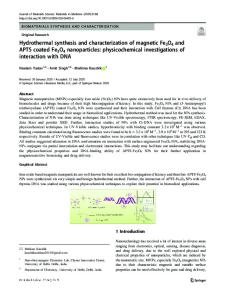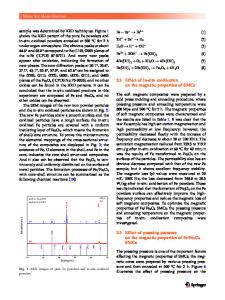Structural, Magnetic and Magneto-transport Properties of Reactive-sputtered Fe 3 O 4 Thin Films
- PDF / 430,176 Bytes
- 6 Pages / 612 x 792 pts (letter) Page_size
- 65 Downloads / 330 Views
1250-G03-02
Structural, Magnetic and Magneto-transport Properties of Reactive-sputtered Fe3O4 Thin Films X.H. Wang1, S. Goolaup1., P. Ren1, and W.S. Lew1, 1 School of Physical and Mathematical Sciences, Nanyang Technological University, 637371, Singapore ABSTRACT Thin films of magnetite (Fe3O4) are grown on a single-crystal Si/SiO2 (100) substrate with native oxide using DC reactive sputtering technique at room tempreture (RT) and 300℃. The x-ray diffraction(XRD) result shows the thermal energy during deposition enhances the crystallization of the Fe3O4 and x-ray photoelectron spectroscopy confirms the film deposited at 300℃ is single-phase Fe3O4 while the film deposited at RT is mostly γ-Fe2O3. The electrical measurements show that the resistivity of the Fe3O4 film increases exponentially with decreasing temperature, and exhibits a sharp metal-insulator transition at around 100 K, indicating the Verwey transition feature. The saturation magnetization Ms of Fe3O4 film measured by vibrating sample measurement (VSM) at RT was found to be 445 emu/cm3. INTRODUCTION The field of spintronics [1] has attracted great research effort recently, due to the potential applications in various spin-based devices [1]. The injection and detection of spin current which can combine with the magnetic recording technique draws large amount of attention to high spin polarized ferromagnetic material[2]. Half metallic materials whose charge carriers are fully polarized at Fermi level have been proposed candidates in magnetoresistive devices such as giant magnetoresistance (GMR) multilayers, spin valves and magnetic tunnel junctions. Among the possible half metallic compound such as Fe3O4, La0.7 Sr0.3 MnO3 and CrO2, Fe3O4 is candidate for future spintronics devices due to the high Curie temperature of 858K[3] and exhibition of full negative spin polarization[4] at room temperature. In order to obtain optimal performance in the applications, Fe3O4 thin film growth with high quality is required. Different techniques have been used such as: molecular beam epitaxy[5], pulsed laser deposition, and sputtering[6]. Various substrates such as MgO, MgAl2O4, SrTiO3, sapphire and Si have been used to study the influence of the lattice mismatch between the magnetite and the substrates. Even though, Fe3O4 is very promising for spintronic devices, it has not been so far optimized for application in this field due to its poor inclusions in device architectures mostly technologically fabricated on semiconducting substrates like Si or GaAs. Fe3O4 films deposited directly on Si substrates, Si with buffer layers as well as GaAs using electron beam evaporation[7] and laser ablation[8] have been studied. In this work, considering the compatibility with most of the devices, magnetite thin films were deposited on surface of SiO2/Si
using DC reactive magnetron sputtering. The Verwey transition[9] feature indicated in the electrical measurements shows that high quality Fe3O4 thin films have been produced. EXPERIMENTAL DETAILS Fe3O4 films were grown by DC magnetro
Data Loading...











